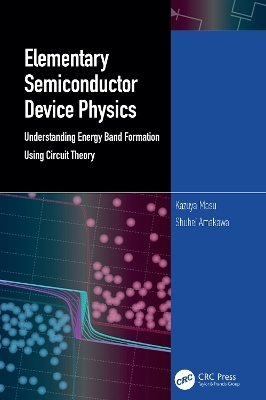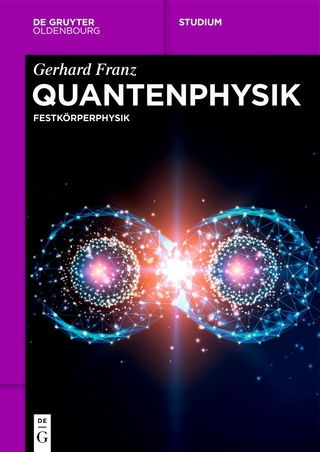
Elementary Semiconductor Device Physics
CRC Press (Verlag)
978-1-032-57447-9 (ISBN)
After briefly summarizing the basics of semiconductors, the authors describe semiconductor devices from a circuit theoretic point of view, making the book especially suitable for circuit design students and engineers. Further to the emphasis on the circuit perspective, the book then uses circuit theory to introduce readers to the famously indigestible “energy bands” of crystalline solids. Additionally, the book explains how to read physics from “energy band diagrams” of semiconductor devices in great detail. The key to appreciating the real power of energy band diagrams is shown to lie in the understanding of the concept of the “quasi-Fermi levels,” introduced in 1949 by William Shockley but remaining elusive to date and therefore often omitted from energy band diagrams. To rectify this, some of the energy band diagrams presented in this book, complete with quasi-Fermi levels, were drawn using a device simulator (a.k.a. technology computer-aided design; TCAD), offering quantitative information about device physics. The book could, therefore, also serve as a hands-on course text in TCAD-drawn band diagram reading.
Because no prior exposure to quantum mechanics is required and the book does not attempt to teach it, this book is ideal for students in various disciplines who may or may not be specializing in semiconductor devices. The numerous practical examples of reading TCAD-based energy-band diagrams are also invaluable to practicing semiconductor device engineers.
Kazuya Masu is President of Tokyo Institute of Technology (Tokyo Tech), a position he has held since 2018. He earned his bachelor’s, master’s, and doctoral degrees in engineering from Tokyo Tech in 1977, 1979, and 1982 respectively. He is a member of IEEE. Shuhei Amakawa is Professor at Hiroshima University. He received his B.Eng., M.Eng., and Ph.D. degrees in engineering from the University of Tokyo, Tokyo in 1995, 1997, and 2001, respectively, and his M.Phil. degree in physics from the University of Cambridge in 2000. He served/serves as a Committee Member for the International Solid-State Circuits Conference and the International Microwave Symposium and is a member of IEEE.
Preface xiv
Symbol Index xix
Chapter 1 ▪ Introduction 1
1.1 WHAT ARE SEMICONDUCTOR DEVICES? 1
1.2 CLASSIFICATION OF SOLIDS 1
1.3 PROPERTIES OF SEMICONDUCTORS 6
1.3.1 Arrangement of Atoms 6
1.3.2 Intrinsic and Doped Semiconductors 7
1.3.3 Carriers in Intrinsic Semiconductors 7
1.3.4 Energy Band Formation 8
1.3.5 Properties of Intrinsic Semiconductors 11
1.3.6 Energy Band Diagrams 13
1.3.7 n-Type and p-Type Semiconductors 16
1.4 WHAT IS THE MOST ABUNDANT ARTIFACT ON EARTH? 23
1.5 SUMMARY 25
1.6 PROBLEMS 26
Chapter 2 ▪ Semiconductor Devices from a Circuit-Theoretic Standpoint 28
2.1 LINEAR CIRCUIT ELEMENTS 28
2.1.1 Linear Resistors 29
2.1.2 Linear Capacitors 29
2.1.3 Linear Inductors 32
2.2 NONLINEAR CIRCUIT ELEMENTS 32
2.2.1 Nonlinear Resistors 33
2.2.2 Nonlinear Capacitors and Inductors 36
2.3 TIME-INVARIANT AND TIME-VARYING CIRCUIT ELEMENTS 40
2.4 MULTITERMINAL ELEMENTS AND CONTROLLED SOURCES 41
2.5 TRANSISTORS 43
2.6 CIRCUIT-THEORETIC POSITIONING OF SEMICONDUCTOR DEVICES 46
2.7 SUMMARY 47
2.8 PROBLEMS 49
Chapter 3 ▪ Waves in Periodic Structures 50
3.1 ANALOGIES IN PHYSICS 50
3.1.1 Commonality of Mathematical Structures 50
3.1.2 Overview of the Chapter 52
3.2 PROPERTIES OF PERIODIC NETWORKS 55
3.2.1 Infinitely Long Ladder Networks 55
3.2.2 Infinitely Long LC Ladders 57
3.2.3 Lossless Transmission Lines 60
3.2.4 Periodic Networks with a Finite Number of Repetitions 66
3.2.5 Kronig–Penney Model 69
3.3 DISPERSION RELATION AND PHASE AND GROUP VELOCITIES 71
3.3.1 Dispersion Relation 71
3.3.2 Phase Velocity and Group Velocity 74
3.3.3 Calculation of the Dispersion Relation 76
3.4 DISPERSION RELATION AND PROPERTIES OF SEMICONDUCTORS 79
3.5 BRAGG REFLECTION 83
3.6 SUMMARY 85
3.7 PROBLEMS 85
Chapter 4 ▪ Physics of Semiconductors in Equilibrium 87
4.1 DENSITY OF STATES IN ENERGY BAND AND DISTRIBUTION FUNCTION 87
4.2 CARRIER DENSITIES OF NONDEGENERATE SEMICONDUCTORS 91
4.2.1 Electron Density 91
4.2.2 Hole Density 93
4.2.3 Product of Hole and Electron Densities 94
4.2.4 Insulators 95
4.2.5 Fermi Level of Intrinsic Semiconductors 96
4.2.6 Carrier Density in Terms of Intrinsic Carrier Density 97
4.3 FERMI LEVEL OF DOPED SEMICONDUCTORS 98
4.3.1 Nondegenerately Doped Semiconductors 98
4.3.2 Degenerate Semiconductors 104
4.4 FERMI LEVEL AND CHEMICAL POTENTIAL 106
4.4.1 Properties of Chemical Potential 106
4.4.2 Chemical Potential in the Presence of an External Force 109
4.5 SUMMARY 112
4.6 PROBLEMS 112
Chapter 5 ▪ Carrier Dynamics in Semiconductors 115
5.1 EQUILIBRIUM AND NONEQUILIBRIUM STATES, STEADY AND NONSTEADY STATES 115
5.2 QUASI-FERMI LEVELS AND CARRIER DENSITIES 117
5.2.1 Quasi-Chemical Potential 117
5.2.2 Electron and Hole Quasi-Fermi Levels 119
5.2.3 Nonequilibrium Carrier Densities 123
5.2.4 Logarithmic Transform of Carrier Densities 125
5.2.5 General Form of Nondegenerate Carrier Density Expressions 128
5.3 QUASI-FERMI LEVELS AND CURRENT DENSITY 129
5.3.1 Carrier Flux Density and Current Density 129
5.3.2 Quasi-Fermi Level Gradient and Current Density 131
5.3.3 Drift and Diffusion of Carriers 132
5.4 ELECTRIC CONDUCTION DUE TO ELECTRIC FIELD 133
5.4.1 Drift of Carriers 133
5.4.2 Relationship between Mobility and Conductivity 138
5.5 ELECTRIC CONDUCTION DUE TO CARRIER DIFFUSION 139
5.5.1 Diffusion Current 140
5.5.2 Einstein’s Relation 141
5.6 CARRIER GENERATION AND RECOMBINATION 143
5.6.1 Direct Generation and Recombination 143
5.6.2 Indirect Generation and Recombination 144
5.6.3 Carrier Generation-Recombination Rates 148
5.6.4 Minority Carrier Lifetime 149
5.7 BASIC EQUATIONS FOR SEMICONDUCTOR DEVICES 151
5.8 DIELECTRIC RELAXATION 155
5.9 DEBYE LENGTH 157
Chapter 6 ▪ p-n Junctions 167
6.1 WHAT IS A P-N JUNCTION? 167
6.2 CONTACT POTENTIAL 168
6.2.1 What Is Contact Potential? 168
6.2.2 Work Function and Electron Affinity 170
6.2.3 Properties of Contact Potential 173
6.3 FORMATION OF A P-N JUNCTION 174
6.3.1 Contact between p-Type and n-Type Semiconductors 174
6.3.2 p-n Junctions in Equilibrium 175
6.3.3 Biased p-n Junctions 177
6.4 QUALITATIVE DESCRIPTION OF RECTIFICATION 178
6.5 ANALYSIS OF ABRUPT JUNCTIONS 181
6.5.1 Zero-Bias Abrupt Junctions 181
6.5.2 Biased Abrupt Junctions 186
6.6 CAPACITANCE OF P-N JUNCTIONS 188
6.6.1 Depletion Capacitance 188
6.6.2 Diffusion Capacitance 189
6.7 ONE-SIDED ABRUPT JUNCTIONS 189
6.8 CURRENT-VOLTAGE CHARACTERISTICS OF P-N JUNCTIONS 190
6.8.1 Equation of Current-Voltage Characteristics 190
6.8.2 Derivation of Current-Voltage Characteristics 191
6.8.3 Additional Notes on p-n Junctions 199
6.9 READING ENERGY BAND DIAGRAMS OF P-N JUNCTIONS 203
6.9.1 Bias Voltage Dependence 203
6.9.2 Lifetime Dependence 208
Chapter 7 ▪ MOS Transistors 215
7.1 MOSFET STRUCTURE AND BASIC CHARACTERISTICS 215
7.1.1 Structure of MOSFETs 215
7.1.2 Basic Characteristics of MOSFETs 218
7.1.3 Outline of Analyzing MOSFETs 221
7.2 MOS CAPACITOR 221
7.2.1 Structure of MOS Capacitors 221
7.2.2 Analysis of MOS Capacitors 222
7.2.3 Classification of Surface Conditions of MOS Capacitors 225
7.2.4 Surface Electron Density and Surface Potential 232
7.2.5 Relation between Gate Voltage and Inversion Charge 234
7.2.6 Relation between Gate Voltage and Surface Potential 236
7.3 THREE-TERMINAL MOS STRUCTURES 240
7.3.1 Back-Gate-Referenced Analysis 241
7.3.2 Channel-Terminal-Referenced Analysis 246
7.4 FOUR-TERMINAL MOSFET 248
7.4.1 Back-Gate-Referenced Analysis 248
7.4.2 Source-Referenced Analysis 256
7.5 SCALING AND SHORT-CHANNEL MOSFETS 257
7.5.1 MOSFET Scaling 257
7.5.2 Short-Channel Effects 260
7.6 SUMMARY 263
7.7 PROBLEMS 264
Chapter 8 ▪ Appendix 269
A.1 MATRIX REPRESENTATIONS OF A TWO-PORT 269
A.1.1 ABCD-Matrix 269
A.1.2 S-Matrix 270
A.2 NTH POWER OF UNIMODULAR MATRIX 272
Chapter 9 ▪ Solutions to Selected Problems 275
A.3.1 CHAPTER 1 275
A.3.2 CHAPTER 2 278
A.3.3 CHAPTER 3 279
A.3.4 CHAPTER 4 281
A.3.5 CHAPTER 5 286
A.3.6 CHAPTER 6 289
A.3.7 CHAPTER 7 292
References 299
Index 303
| Erscheinungsdatum | 02.11.2024 |
|---|---|
| Zusatzinfo | 15 Tables, black and white; 154 Line drawings, black and white; 154 Illustrations, black and white |
| Verlagsort | London |
| Sprache | englisch |
| Maße | 156 x 234 mm |
| Gewicht | 830 g |
| Themenwelt | Naturwissenschaften ► Biologie |
| Naturwissenschaften ► Physik / Astronomie ► Festkörperphysik | |
| Technik ► Elektrotechnik / Energietechnik | |
| Technik ► Umwelttechnik / Biotechnologie | |
| ISBN-10 | 1-032-57447-X / 103257447X |
| ISBN-13 | 978-1-032-57447-9 / 9781032574479 |
| Zustand | Neuware |
| Informationen gemäß Produktsicherheitsverordnung (GPSR) | |
| Haben Sie eine Frage zum Produkt? |
aus dem Bereich


